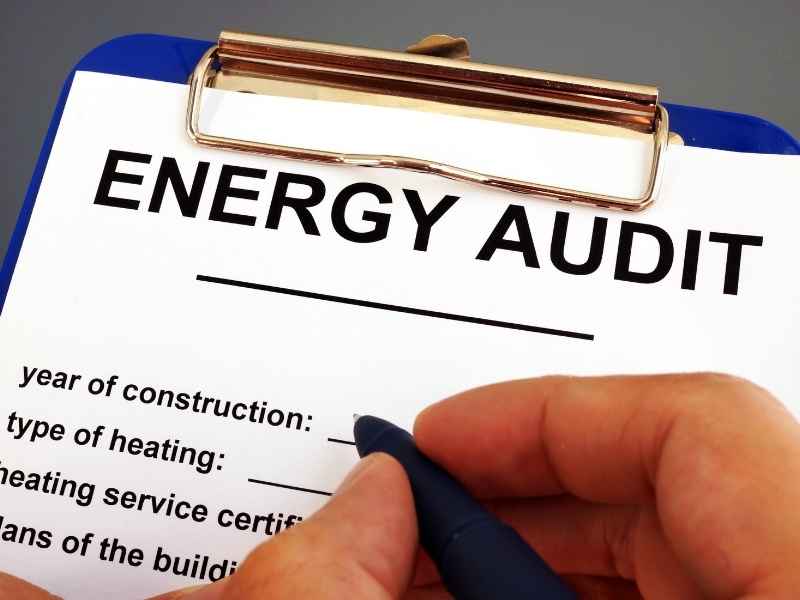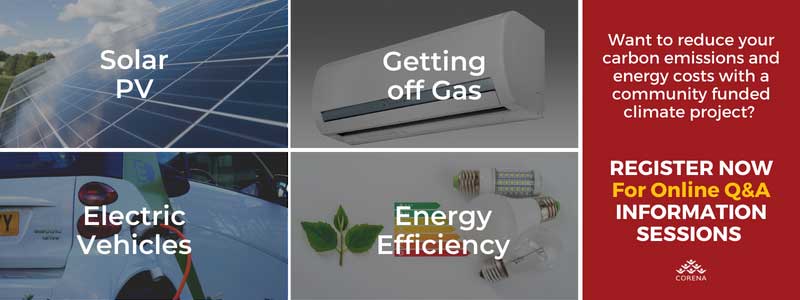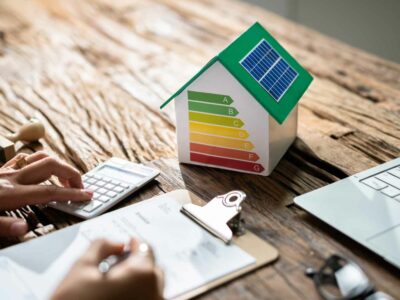One of the first places to start when considering how to cut carbon emissions and energy costs is to conduct an energy efficiency audit. By understanding how and when your organisation is using energy, you’ll be better placed to make use of renewable energy sources, such as installing solar panels, or swapping out old inefficient appliances for newer more environmentally friendly alternatives.
In this guide, we’ll tell you why an energy audit is important and explain what is involved with the energy auditing process.
What Is An Energy Efficiency Audit?
The word “audit” is most often used in the business world and involves an inspection of accounts and reports. An energy audit (or assessment) is similar except it looks at your energy use (both electricity and gas) in detail.
A good audit looks at everything. The interior, exterior, appliances, and equipment of your premises are carefully checked.
Some organisations like to do a water audit at the same time because water and energy are closely related. For example, by reducing water use you often reduce your water heating requirements.

Why carry out an energy audit of your organisation?
It might seem that an energy audit is time consuming, however when done effectively it can hugely benefit your organisation.
After your energy audit, you will have a blueprint which you can use as the basis for a plan to both optimise your energy use and lay the groundwork for installing renewable energy like solar panels.
Pinpointing where there is energy wastage can often result in simple cost-free actions that lead to long-term savings, and also help to significantly lower your organisation’s carbon footprint. Every energy auditor has many stories about finding air conditioning timers set for out of hours, or an undetected hot water leak. Sometimes an organisation can be blissfully unaware of the energy that is being wasted especially if it has continued for a long time. They may think that their bills are expensive but have not significantly changed, so they must be normal. When an auditor finds things like this that are easily rectified an audit can easily pay for itself with the cost savings which often run into the thousands.
Where an audit identifies that you need to upgrade equipment, it should provide you with figures you can use to argue your case for the investment. You should receive an estimate of capital cost, energy savings, return on investment measures such as Net Present Value and Internal Rate of Return, and payback period.
It should also provide estimated maintenance costs over the lifetime of the equipment. This information is extremely valuable for securing capital and for use in grant applications.
A thorough energy audit can be beneficial for both staff morale and the reputation of your organisation by promoting teamwork and innovation. With more employees looking to work in for-purpose or ethical businesses, energy audits can help show your staff and customers you are actively reducing emissions. Undertaking such a project can not only lower costs, but also show your organisation’s commitment to tackling the climate emergency as well as generate interest and buy-in from the public.
When an organisation shows it is serious about implementing initiatives suggested by an energy audit, team members often become enthusiastic about finding other ways that energy can be saved and open to adopting new beneficial practices that can also help to green your workplace.
Learn more in 7 Ways To Green Your Workplace & Boost Energy Efficiency
How To Undertake An Energy Efficiency Audit Of Your Organisation
An energy audit can take a number of forms.
For a small organisation it’s possible to complete a very basic assessment yourself or with the help of CORENA. To start, we can talk you through your appliances and energy use over the phone to see if there is anything major you can change.
A free tool like Climate Clever can help walk you through the process.
Larger organisations with offices, centralised Heating Ventilation and Air Conditioning (HVAC) or complex equipment such as manufacturing equipment or boilers would benefit from a professional completing an energy audit. Energy audits vary greatly in quality so to ensure you get useful information it is important you are specific in what you ask for.
There is an Australian Standard for Energy Audits which lists 3 types. You can ask an energy auditor to carry out their audit to one of these 3 levels which will ensure that your audit is done to a certain standard.
Level 1 – Basic
- Cheapest.
- Includes general recommendations.
- Can be used as an initial site assessment to see if a more detailed analysis is required.
Level 2 – Detailed
- Detailed site inspection and staff consultation.
- Analysis of available data (including bills and meter data without installing data loggers).
- All savings below a 4 year payback quantified to medium accuracy.
This should include the estimated capital cost, energy savings, non energy savings and payback allowing you to use this information to argue for a project.
Level 3 – Precision sub system audit
- Detailed assessment of a particular system.
For example you may be having a lot of maintenance issues with your HVAC system and ask the energy auditor to assess this in detail to see if this means it is also using a lot of energy. This level of audit should provide you with detailed recommendations specific to your situation with comprehensive costs and energy savings to the level that would allow you to budget for an upgrade.
The Energy Efficiency Council has an excellent quick reference guide to the Australian Standard energy audit levels here.
For most non profits a Level 2 audit would be suitable. This is detailed enough to give you useful information specific to your organisation.
The other way to make sure you get a good report is to ensure you choose a qualified energy auditor. A NABERS accredited assessor is a good start. You can search for assessors in your area here. CORENA might also be able to give you the names of auditors that our volunteers have worked with in the past.
A good energy audit or assessment will follow these 8 important steps…
1. Analyse Existing Use
A good place to begin is to see how your energy is being used at present, so an energy auditor will start by looking at recent energy bills. There is a lot of useful information in them.
For a comprehensive view of power use (electricity and gas), you need at least 12 months of data showing energy-use patterns. This information should unmask gaps and identify your organisation’s top sources of energy use.
Knowing where and when your organisation uses energy is vital to uncovering ways savings can be made and areas which need improvement. Look for any inefficiencies across all parts and properties of your organisation.
Sometimes you need data with more detail to help understand your energy use. On a smaller scale a plug in energy monitor can see how much energy a particular appliance is using.
For larger buildings, there are sub-meters and data loggers that energy auditors can arrange to have installed that measure energy use for a particular end use (such as HVAC) at regular intervals throughout the day. You can install these to get data for specific operations. They allow the auditor to get a much better picture of where your energy is going and when, to help formulate their recommendations. For example, your data logger might show a high overnight usage which might mean that an air con timer is coming on at the wrong time.
These meters provide real-time information about how much energy you are using and what this costs. Some energy retailers may also be able to give you access to data read by your meter every 10-30 minutes for free. Check your online electricity account to see if this is available with your account.
Once you’ve got the data, then it needs to be analysed, taking into account daily, monthly, or seasonal variations.

2. Walkaround
To complement this collection of data, an energy auditor will take a systematic walk around your workplace and premises to prepare an inventory of equipment and spot other potential energy-saving opportunities.
Here are some common examples of what they might discover as they walk around:
- A thermostat that might serve its purpose better in another location clear of doorways, windows, skylights, and other draughty places.
- Old unused fridges.
- Air con timers set for out of hours.
- Pumps running continuously when water is not being used.
- Old resistive electric or gas hot water systems.
- Parts of a building that are unusually hot or cold indicating that the air conditioning is not working properly.
- Unshaded windows facing east or west that allow a lot of heat into the building.
- Insulation poorly installed or not at all.
- Hot water leaks.
Look at your current light bulbs. Are they old or halogen? maybe it’s time they were replaced with far less energy-hungry options like CFL or LED bulbs. If you think this might be an issue, an energy assessor can do a detailed assessment of your lighting, calculating your energy use from the number and types of lights and then working out how much power upgrading them would save.
There are many things people think save energy but they may not actually be a major energy consumer or the most cost effective to replace. This is why it’s so valuable to have a professional assess your building and crunch the numbers for your particular situation.
3. Data Analysis
One of the challenges of having so much data is then interpreting and making sense of it. Some common analysis techniques are:
- Plotting Graphs of energy use over time to find patterns in power use. These graphs can encompass all sorts of use- seasonal, monthly, weekly, daily even hourly
- Graphs showing energy use versus activity, production, or possibly other parameters
- Comparing energy performance to find if a process, facility, or business unit is working at an optimum level, or to compare different sites.
4. Establish Energy Baseline
An important step in your energy audit is the setting of the energy baseline. This is the date when you actively start to improve processes. Ideally, you should have collected data for at least 12 months. Then comparisons can be made before and after the baseline.
Improving your energy efficiency is an ever ongoing and evolving process as your operations and technologies change. Ideally you would do an energy audit every 3-5 years or after you have made a major change or upgrade. Your energy use baseline allows you to track your progress over this time.
5. Actions & Recommendations
If you are doing a simple energy audit yourself, you may have found some changes you can make, so now you need to calculate how much these changes will save you. For example, you may decide to remove some unnecessary fridges. A plug in energy monitor will tell you how much you will save by doing this. This energy rating calculator is also a great tool to calculate savings and compare options for a replacement.
At this time, you can contact suppliers and installers, who can give quotes for upgrades.
Comparing possible savings and costs will reveal payback times for each possible improvement. This makes it possible to set priorities in regards to implementation.
If you have had a professional energy audit completed, the energy audit report should provide a list of energy saving actions with detailed costings.
6. Business Case
Having looked at current energy usage and put together an action plan, you’ll more than likely then be able to begin implementing some of the lower-cost actions.
However, more extensive projects may need some external funding. For such a situation, you’ll need a business case that is more formal to justify your ideas.
Although every project is different, certain elements need to be in the business case. These include:
- The justification for the project
- How the solution was found and what it is
- A plan that shows the project’s requirements, including a proposed timeline for implementation
- A detailed breakdown of costs, both time, financial, and resource
- A cost-benefit analysis of the solutions proposed
- Analysis of risk – detail any associated risks, and how they can be mitigated
7. Explore Funding Options
If you haven’t been able to source funding for your projects, CORENA works with a wide range of not for profits, charities, social enterprises and community organisations, and provides zero-interest loans to fund projects that reduce carbon emissions and energy costs.
If approved for funding, you will not pay any interest on a CORENA loan, and the quarterly loan repayments are set to be a little less than the savings on your operating costs averaged over a year. This means you are never out of pocket and after your loan is fully repaid you reap the full financial benefit of having lower operating costs.
Learn more in 5 Ways CORENA Helps Non Profits Reduce Carbon Emissions & Energy Costs
8. Track Results
Finally, keep a log of progress and highlight improvements in your organisation’s energy use as time passes. Such data can be used to help justify future renewable energy and climate projects.
CORENA Assistance For Energy Efficiency Audits
Depending on the size of your organisation and the complexity of the equipment a professional Level 2 energy audit is likely to cost between $1,000-$5,000. This might seem like a lot but compare it to your annual energy costs. For larger organisations this is often only a small proportion of their annual energy bill and well worth the investment if you find it can reduce your bill significantly. CORENA is always happy to answer questions about energy audits and talk you through the process of having one done. If you need a zero interest loan to fund your audit, get in contact, we are able to fund these in certain circumstances.
To learn more about your organisation’s eligibility for CORENA community funding, check out our how to apply for a project loan page, or register for one of our upcoming Online Q&A Information Sessions.


